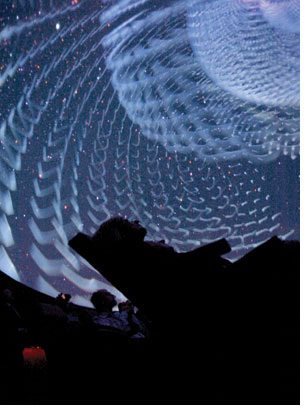Back
 |
| The new high-resolution Buhl Digital Dome at Carnegie
Science Center is taking exploration from the seat
of a planetarium to exciting new dimensions. |
If
you think you’ve done the planetarium thing—think
again. Buhl Digital Dome is not your father’s planetarium.
And we’re not just talking about a name change. In late
September, full-dome digital technology literally transformed
the renowned Henry Buhl, Jr. Planetarium & Observatory
at Carnegie Science Center into Buhl Digital Dome, providing
real-time capabilities once unimaginable. It’s still
a thing of dreams for more than 90 percent of all planetariums
worldwide.
As it has been for decades, the magnificence of
the universe—eclipses
and shooting stars and the now demoted dwarf planet Pluto
and everything in between—is live at the planetarium
every day. One extraordinary difference is the ability for
viewers
to now watch the drama unfold—in real time—almost
as it happens. It’s like a reality show starring the
solar system.
“
Within hours of NASA making an announcement, we can have
images of the event or discovery directly from their
telescopes up
on the dome for people to see and discuss,” says
John Radzilowicz, director of visitor experience at Carnegie
Science
Center, home to the new, groundbreaking digital projection
system DigitalSky, purchased in May 2006 thanks
to a $1 million gift from the Buhl Foundation.
The high-definition
system projects film-quality presentations
onto the planetarium’s entire 50-foot dome. And its
multi-media capabilities allow the use of everything from
live downloads
of the latest images and updates from NASA’s unmanned
space missions and ground-based observatories to video
clips, still images, and animation—tooling programmers
with almost endless possibilities for teaching, not to
mention jaw-dropping
effects.
And then there’s the ability to ‘fly’ wherever
you want through the universe—so sit back, relax,
and name your destination.
“Within a presentation we now have the ability to
ask viewers what they’d
like to see. It’s incredibly interactive,” says Radzilowicz. “We’re
at Mars but Johnny wants to go to Pluto—and within seconds, we’re
there.”
And when ‘flying’ to a planet—made possible
through a behind-the-scenes database developed by NASA—not only
can visitors see where the sun is located at that very moment, but how
it will
be lit later that evening or 10 years from
now through a three-dimensional rendering of space that is visually and
mathematically accurate. Kids won’t be surprised to know that,
fittingly, the system is in part directed by a joystick.
Shooting for
the stars is anything but new for the 150-seat Buhl Planetarium—officially
renamed Buhl Digital Dome early this fall to reflect its new capabilities.
It has the ability to project digital images of any kind, starting with
planets
and the cosmos and expanding to everything from advances in biology and
biotechnology, medicine, nanotechnology, environmental studies, engineering
and architecture.
Shows already provide journeys through the human body and the ocean floor.
“The new Buhl Digital Dome is awesome,” says
Joanna Haas, Henry Buhl, Jr. director of Carnegie Science
Center. “It’s a great place for
families, especially over the holidays when we’ll be showing ‘The
Christmas Star’ planetarium show using the new digital system.”
The
debut show, "Windows to the Universe," wows audiences by
showcasing the system’s potential. The first original production
by the Buhl Digital Dome team, a virtual trip to Mars based on William
K. Hartmann's book, "A
Traveler's Guide to Mars," will premiere next spring.
“
For decades, thousands of children and adults have been inspired by what they
have seen in the Buhl Planetarium,” says Doreen Boyce, president of the
Buhl Foundation. “This new technology is the most advanced teaching tool
of its kind, and it will inspire and educate many more thousands of people for
years to come.”
Thanks in no small way to the ongoing generosity of the
Buhl Foundation, the Planetarium has indeed packed plenty of star power over
the years, producing
presentations currently shown in 400 planetariums worldwide in 21 countries,
and translated into 18 languages. But before DigitalSky, projections were stitched
together. Now, the all-in-one solution uses two lenses to project full-color,
three-dimensional images—the most advanced digital dome know-how in the
world—providing viewers a true feeling of immersion, which will generate
even more production capability and revenue.
This addition also marks the first
step in the largest transformation of visitor experiences at Carnegie Science
Center since its arrival on the North Shore in
1991. The long-range plan centers on the Science Center’s own unique strengths
as well as those of the regional technical community—rivers and our environment,
robotics, sports, health and the body, and the “basic building
blocks of science”—to spark scientific curiosity in young children.
Back
| Top |